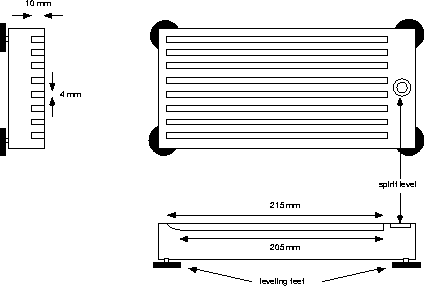Attention: World-2DPAGE is no longer maintained.
[Top] [Prev] [Next] [Bottom]Immobilized pH gradient (IPG) as first dimension
Racket-shaped IPG
A new sigmoidal immobilized pH gradient (IPG) was used as the first dimension. It offered high resolution and great reproducibility and allowed high protein loads. Based on our specifications, the non-linear pH gradient strips were prepared by Pharmacia LKB Biotechnology AB and are commercially available. The strips were 3 mm wide and 180 mm long. In addition, the geometry of the immobilized pH gradient strips has been changed to allow the use of large sample application cups that can accommodate greater sample volumes (see sample preparation). The use of narrow range IPG with a large sample loading volume allowed an efficient resolubilisation of polypeptides after the first dimension. As a result, the vertical streakings caused by too high a protein concentration were eliminated in the second dimension [6-12].

Narrow IPG gel strips preparation
A variety of recipes were used giving IPG's with a width of 0.4 to 1 pH units. The strips were cut in a form to allow sample application in sample cups of 16 x 11 x 6 mm [8].
IPG gel strips rehydration
Hydration was performed overnight in the Pharmacia reswelling cassette with 25 ml of a solution containing urea (8 M), CHAPS (2% w/v), DTE (10 mM), Resolyte pH 3.5-10 (2% v/v) and a trace of Bromophenol Blue [8].
Sample application
When the rehydration cassette had been thoroughly emptied and opened, the strips were transferred to the Pharmacia strip tray. After placing IPG strips, humid electrode wicks, electrodes and sample cups in position, the strips and cups were covered with low viscosity paraffin oil. Samples were applied at the cathodic end of the IPG strips in a slow and continuous manner, without touching the gels [8].
Running conditions
The voltage was linearly increased from 300 to 3500 V during 3 hours, followed by 3 additional hours at 3500 V, whereupon the voltage was increased to 5000 V. A total volthourproduct of 400 kvh was used in a four days run [8].
IPG gel strips equilibration
After the first dimension run the strips were equilibrated in order to resolubilise the proteins and to reduce -S-S- bonds. The strips were equilibrated within the strip tray with 100 ml of a solution containing Tris-HCl (50 mM) pH 8.4, urea (6 M), glycerol (30% v/v), SDS (2% w/v) and DTE (2% w/v) for 12 min. -SH groups were subsequently blocked with 100 ml of a solution containing Tris-HCl (50 mM) pH 6.8, urea (6 M), glycerol (30% v/v), SDS (2% w/v), iodoacetamide (2.5% w/v) and a trace of Bromophenol Blue for 5 min[8].
In-gel sample rehydration
Two-dimensional polyacrylamide gel electrophoresis (2-D PAGE) is one of the most powerful technique for the study of protein expression and their post-translational modifications. However, the separation of low copy number proteins in amounts sufficient for post-separation analysis continues to present a challenge for 2-D techniques. Improvements in shortening the focusing time, increasing the loading capacity and enhancing resolution is still needed. We developed a simple methodology for sample application suitable for commercially available or home-made IPG strips. To achieve this, we have adapted the concepts of "volume-controlled rehydration" and "in-gel sample rehydration", but modified the approaches to exploit the reproducibility offered by commercially available IPG strips.

IPG gel strips rehydration and sample application
Hundred µg to 15 mg of proteins were solubilized with 500 µl of a solution containing 8 M urea, 4% CHAPS, 65 mM DTE, 0.8% resolytes 4-8 and a trace of bromophenol blue. To achieve reswelling and simultaneous loading of the sample, the entire samples were pipetted into the grooves, narrow (1 pH unit) or wide range IPG strips (3.5-10 NL, 18 cm from Pharmacia Biotech. or home-made) were positioned such that the gel of the strip was in contact with the sample (up side down), and the gel and the sample were covered with 3 ml low viscosity paraffin oil to avoid evaporation. Strips were then left at room temperature for six hours or overnight. The rehydrated IPG gels carrying the protein sample were removed from the grooves with tweezers, rinsed with water and positioned on the Pharmacia strip tray as described by the manufacturer.
Running conditions
The voltage was linearly increased from 300 to 3500 V during 3 hours, followed by 3 additional hours at 3500 V, whereupon the voltage was increased to 5000 V. Focusing was carried out for a total of 100 kVh. IPG gel strips equilibration
After the first dimension run the strips were equilibrated in order to resolubilise the proteins reduce -S-S- bonds. They were equilibrated for 12 min in the reswelling chamber using 3 ml per groove of buffer 1 (50 mM Tris-HCl pH 6.8, 6 M urea, 30% v/v glycerol, 2% w/v SDS and 2% w/v DTE), and then -SH groups were subsequently blocked for 5 min using buffer 2 (50 mM Tris-HCl pH 6.8, 6 M urea, 30% v/v glycerol, 2% w/v SDS, 2.5% w/v iodoacetamide and a trace of bromophenol blue). Buffers are easily removed by aspiration.
[Top] [Prev] [Next] [Bottom]